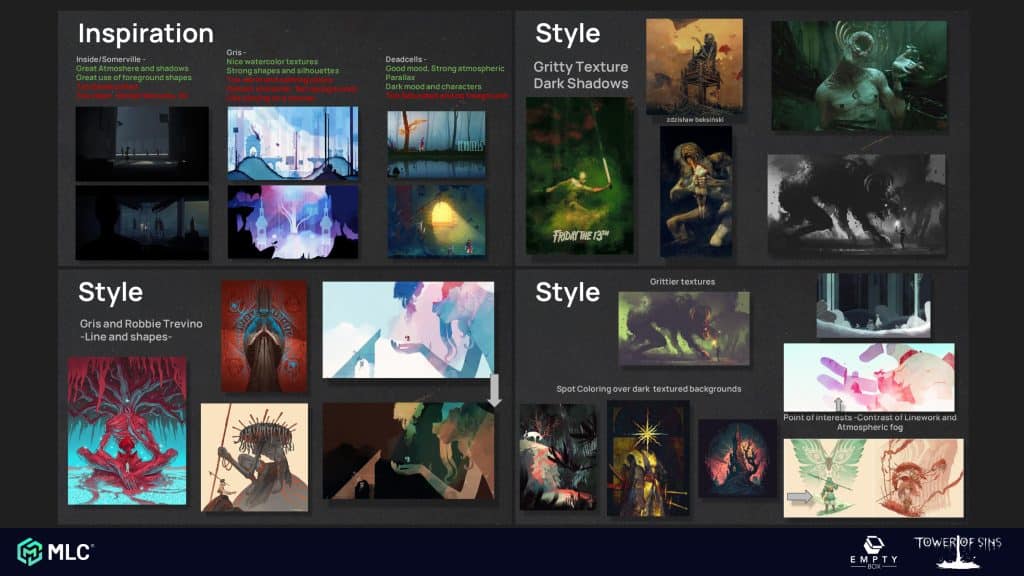In video game development, there’s an unsung hero that often remains hidden behind the scenes, yet their influence is felt throughout every visual aspect of the game. This hero is none other than art direction, a cornerstone of game development that wields immense power in shaping the player’s experience and the overall success of a game.
In this blog post, you’ll explore why art direction is so important in game development and how it influences the way your players will perceive and engage with your game.
Art Direction Sets The Stage
Art direction serves as the guiding light that helps game devs create a consistent, captivating world for players to truly immerse themselves in. By defining a cohesive visual style, art direction ensures that all elements of the game adhere to a unified aesthetic.
Consider a fantasy RPG where the art direction leans towards a vibrant, fantastical style with whimsical creatures and colourful landscapes. Such a visual approach immediately communicates the game’s nature to players, allowing them to emotionally connect with the game’s world on a deeper level. On the other hand, an art direction that clashes or lacks consistency might disrupt this immersion, pulling players out of the experience and diminishing their engagement.
Let’s take Stray as an example here, it goes beyond the conventional approach to dystopian and futuristic cityscapes. Instead of opting for a dark and gloomy atmosphere, the game’s art direction presents a bright and distinctive cityscape. This unique design provides a striking backdrop that contrasts with the darker undertones of the game’s world, setting it apart from other dystopian-themed games. We took a deep dive into the art behind Stray in a blog post last year, take a look. 👀

Great Art Direction Conveys Narrative And Emotion
Art direction is also a storyteller. Through carefully devised visuals, it communicates narrative elements, emotions, and themes to players without the need for excessive commentary. The choice of colour palettes, lighting, and visual motifs can all give insight into the game’s world, mood, characters, and underlying conflicts which in turn enhances the player’s enjoyment and engagement with the game and in turn the game’s marketing.
Think about when you’ve played a survival horror game, the dark and oppressive art direction with shadows that seem to loom at every corner. This visual approach instils a sense of dread and vulnerability in players, enhancing the game’s scary atmosphere and the player’s anxiety at every turn.
In contrast, a more light-hearted art direction might signal to players that they’re in for an adventure, filled with wonder and discovery. In both cases, the art direction becomes a silent part of telling the story.
Smart Art Direction Allows For Differentiation And Branding
In an industry flooded with countless games fighting for players’ attention, it’s safe to say standing out becomes paramount. Great art direction is a powerful tool for differentiation and branding, a distinctive visual style can instantly make a game recognizable among the sea of options.
For instance, the cell-shaded, comic book-inspired art direction of “Borderlands” became a hallmark of the series, making it instantly recognizable and setting it apart from the competition. This unique visual style not only drew players in but also created a dedicated fan base that associates the art direction with the franchise’s identity.
Art Direction Directs Player Focus
Art direction isn’t just about aesthetics; it’s also about guiding players’ attention. skilful use of colour, composition, and visual hierarchy can direct players’ focus to key elements, such as important objects or objectives, making for a seamless, intuitive and engaging gameplay experience.

Art director’s expertise involves drawing on diverse artistic references, past and present, to establish a cohesive style that communicates a specific message. It also entails skillfully using lighting and perspective techniques to enhance the visual impact of scenes and key elements of the game.
Meticulous Art Direction Keeps The Game Congruent To The Universe
Art direction plays a pivotal role in ensuring that video games remain faithful to the worlds they depict. An illustrative example of this can be seen in the meticulous attention to historical accuracy needed when designing the game environment.
For example, when crafting a game world set in medieval times, art direction is essential in preventing elements from different eras from infiltrating the narrative.
Consider the case of barbed wire, a fairly recent invention (1873), it’s necessary to ensure that such modern inventions are absent from the game’s medieval setting, maintaining the integrity of the time period and enhancing the player’s immersion in an authentic and coherent gaming experience. In this way, art direction serves as the guardian of historical consistency, preserving the unique atmosphere and storytelling of the game’s universe.
Conclusion
In game development, it’s clear from these examples and blog posts like those found on Game Developer that art direction shines as an imperative force that binds the elements of a game together. It moulds the world players explore, amplifies emotions, and tells stories through visuals. Art direction isn’t merely an afterthought; it’s a foundational pillar that breathes life into virtual worlds and transforms them into memorable, engaging experiences for players to cherish.
